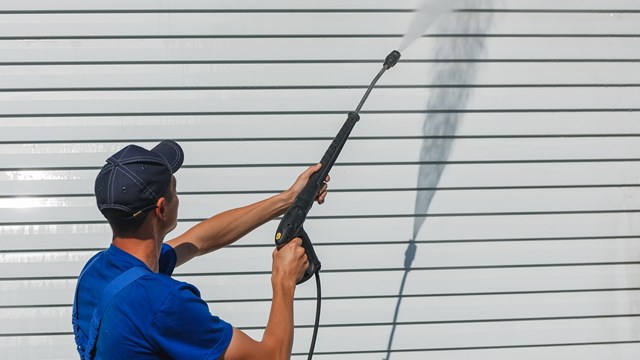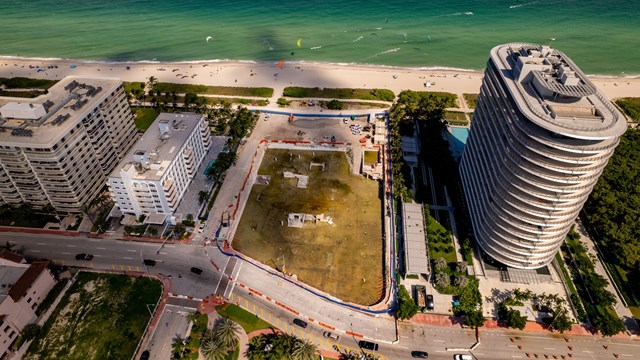Living in a dense urban area like Chicagoland can be something of a dirty job. And the task of cleaning off months (or years) of accumulated grime and dirt from the exterior of a building takes much more than a scrub-brush and a bottle of Windex; it requires professional help. This is not just a labor-intensive job, it also calls for extensive knowledge of building materials, cleaning products, and cleaning methods.
Removing the Dirt
For residents of condos, townhomes and co-ops, knowing when, how and why—or why not —to have the exterior of their building cleaned could be a matter of dollars and cents, but it also should be about what makes common sense. Most associations would find it unnecessary to clean their building’s entire exterior each month, but some might want it done semi-annually, while others could allow the façade to darken for years before tending to it. It all really depends upon a community’s perceptions, needs, and budget.
“The most common types of stain and grime found on Chicagoland area buildings would be associated with the building's environment,” says Jeff Foy, director of sales and marketing for ACS Powerwash in Northfield. “Soot, construction debris, bird droppings, road salt, mold and moss all contribute to a building looking dirty or unkempt.”
“Air pollution, mold, car exhaust and moisture all are contributing factors to grime and dirt on Chicago buildings,” adds Mike Landry, a sales representative at Dakota Evans Restoration, Inc. in Palatine. “It depends on the actual surface. The grime or dirt that we see in newer buildings is usually associated with moisture infiltration because the building material being used in the last ten years or so isn't strong or well-manufactured as they were years ago. But we also see a lot of carbon buildup in natural materials like limestone— and that's from mostly general pollution.”
Aside from looking terrible, some long-term problems may be associated with letting dirt and grime accumulate on your building. That dirt can create a sealing barrier that won’t allow the building exterior to “breathe,” and thus, cause problems such as water retention. Also, calcium and sulfates left on a building facade create acidic conditions and salts which can penetrate and cause deterioration to the masonry and underlying materials.
“Dirt and grime on a building can attack the exterior coatings,” warns Keith Moore, president of U.S. Exterior Maintenance & Repair in Plainfield. “It can attack the paint, which cuts down on its life span. It can also cut down on the life span of waterproofing agents and the life of mortars.”
“The longer dirt and grime is allowed to stay on a building the harder it can be to remove and it can cause stains that are potentially permanent,” adds Foy. “Accumulations of dirt and debris can hold water and contribute to leaks and rot.”
Other, less-tangible effects of grime and stains on a building’s exterior include an erosion of residents' pride of ownership, as well a less-than-great first impression for prospective buyers. Curb appeal is a real factor which can have a major impact on a person’s decision to buy or not buy a unit in a particular building. A structure with a clean, sparkling exterior, free from grime and stains will be more appealing to both the residents who live in it as well as those considering buying into it.
Cleaning Frequency
How often a building’s exterior should be cleaned varies, based upon a number of factors, including how long it’s been since the job was done, how well the job was done previously, what the façade is made of, the building’s budget and other considerations. For some communities, an exterior cleaning can be done in stages, with just the front façade being professionally cleaned on a regular basis, and the rest of the exterior getting the once-over less frequently.
Periodic facade cleaning is recommended by professionals and will vary based on factors such as location of the building, exposure to atmospheric contaminants such as exhaust and acid rain, as well as the type of construction. Limestone, granite, brick and concrete are cleaned in different ways, depending upon the severity of grime, and the cleaning methods chosen by the contractor.
The frequency of cleanings also varies from brick to limestone to concrete. Softer materials such as limestone and some types of molded bricks can require more gentle cleaning methods, and may forego restoration cleaners completely in favor of pure water soaking. This method involves the contractor attaching a soaking system to the building’s façade at the rooftop, then allowing the soaker to wet the façade of the building continuously in a very low-pressure spray for a day. After, grime is easily power-washed off of the building’s exterior.
Usually contractors do an exterior cleaning from the top of the building to the ground floor. Sometimes the building’s board just asks for the front façade of the place to be cleaned, and that the other three sides of the exterior be left alone. “Everything depends on the priorities of the building,” says Landry. “We tend to tell people to clean their building to promote the higher value of the units – clean it when it looks like it needs to be cleaned. Most of the higher-end condos don't mind spending money on cleaning, while smaller or less well-off condos may just not have the money to do the cleaning. It's often a matter of budget.”
“It depends at what point an owner or board feels it's cosmetically necessary to clean,” says Moore. “A dirty building takes away from curb appeal. There are some buildings that can go 15 years without being cleaned, and you've got others that should be cleaned every 24 months because they're located near an expressway or a power plant. There are so many variables going into it, I recommend that building owners evaluate their buildings every year and see what's needed.”
Methods & Materials
Generally speaking, contractors across the board use the same arsenal of methods to clean buildings. Depending upon the job, varying combinations of high and low pressure water, detergents, strippers and acidic cleaners are used with spray bars and brushing to achieve the desired effect. It's sometimes impossible to tell whether a given approach will work without testing it on a small, discrete patch of the exterior first. “The final method for cleaning a building's facade should be chosen only after performing field tests to determine the mildest approach that is effective without causing damage to the building's façade,” says one pro.
To keep at least the ground floor of the building’s exterior looking its best between professional scrubbings, the staff should power-wash the exterior at least once a month. Some buildings have such a quick cleaning done more often.
While the basics of building cleaning may have stayed consistent over the years, the chemicals and processes used these days are far less caustic than in years past. While cleaning chemicals in the past would leave streaks on windows they came into contact with, newer chemicals will not.
“The basic functionality of a professional pressure-washing equipment has remained unchanged for decades,” says Foy. “Big advancements have been made in the detergents used to get the work done. With increasing effectiveness of biodegradable surfactants, there are very few situations a qualified pressure washing contractor cannot correct, or at least improve. 20 years ago, contractors were using corrosive products that could damage and harm wildlife. Now with an array of safe products the impact on our environment has been reduced significantly over the years."
The pros agree that picking the right contractor is one of the most important aspects of undertaking an exterior cleaning of a residential building. A board should truly vet the contractor before hiring him, and make sure the company has done the same kind of work for other clients. Then the board should check how well that work was done.
Finally, the board should check the contractor’s insurance papers for the work to be done on the building—or have the building’s attorney eyeball the papers—to ensure that the insurance covers everything that it should. If it doesn’t and things go wrong with the job, the building’s residents could be left holding the bag.
Jonathan Barnes is a freelance writer and regular contributor to The Chicagoland Cooperator. Staff writer Christy Smith-Sloman contributed to this article.







Leave a Comment